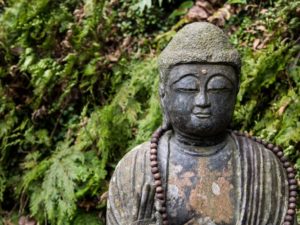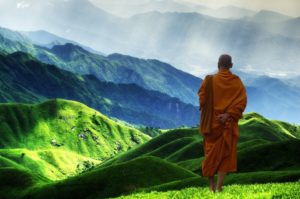One of the admirable things about Buddhism is the very sound logical system they have developed through diligent study, experiment and debate. The Buddha taught his disciples to test his teachings with reason, logic and experience and not to believe him on the basis of dogma. The Dalai Lama, who has become very interested in science over the years, is known to say that faith without reason is worthless. So far, all of Buddhism’s Laws or theories run parallel to those of science, especially quantum physics. (See the Dalai Lama’s book, The Universe in a Single Atom).
 The central tenet in Buddhism is the idea of Dependent Origination also known as Interdependent Arising which posits that nothing can exist on its own. That is, there is no inherent existence in anyone or in any phenomena because one thing must depend on other things such as a water, oxygen and a certain narrow band of temperatures for humans to survive or like bubbles appears out of certain causes such as soap, water, air and humidity and they cease to exist when one of these causes breaks down and usually these conditions only last for a matter of seconds and the bubble disappears. Lightning can also serve as an analogy of Dependent Origination. What one calls “lightning” only exists when the causes and conditions necessary for producing static electricity occur. So, while people use words to describe concepts, the words are only words, not the thing being described. Hence, there is no inherent or non-causal element in existence. The one exception some Buddhists argue is the primordial presence of the Buddha Mind that exists without causation in each sentient being and fills the entire universe.
The central tenet in Buddhism is the idea of Dependent Origination also known as Interdependent Arising which posits that nothing can exist on its own. That is, there is no inherent existence in anyone or in any phenomena because one thing must depend on other things such as a water, oxygen and a certain narrow band of temperatures for humans to survive or like bubbles appears out of certain causes such as soap, water, air and humidity and they cease to exist when one of these causes breaks down and usually these conditions only last for a matter of seconds and the bubble disappears. Lightning can also serve as an analogy of Dependent Origination. What one calls “lightning” only exists when the causes and conditions necessary for producing static electricity occur. So, while people use words to describe concepts, the words are only words, not the thing being described. Hence, there is no inherent or non-causal element in existence. The one exception some Buddhists argue is the primordial presence of the Buddha Mind that exists without causation in each sentient being and fills the entire universe.
The discovery of the Boson existing within the Higgs field is an incredible achievement.
The whole process replicates what the universe was like a trillionth of a second after the Big Bang. The Higgs-Boson was discovered at the same time in two different experiments the CMS and the Atlas, both at the Large Hadron Collider in Geneva at CERN ((European Organization for Nuclear Research). The probability of both experiments findings identical data is uncanny. “By combining data sets from both experiments, the researchers are able to confirm the existence of the particle at the gold standard of 5 sigmas. There is about a one in 3.5 million chance the scientists would get these results if the Higgs-Boson didn’t exist.” (New York Times, Physicists Find Elusive Particle Seen as Key to Universe, Dennis Overby.)
 Buddhists, being non-theists do not believe in a Supreme Being which exists outside of the Laws of Cause and Effect. So then, the Buddhist must question where the Boson particle arises. The Buddhist will assume there is another cause for this phenomenon. Scientists will also be looking for causes and further experiments will be conducted…
Buddhists, being non-theists do not believe in a Supreme Being which exists outside of the Laws of Cause and Effect. So then, the Buddhist must question where the Boson particle arises. The Buddhist will assume there is another cause for this phenomenon. Scientists will also be looking for causes and further experiments will be conducted…
If science shows that the Higgs-Boson does exist on its own, that it does not depend on any other cause, and Buddhists would have to consider the possibility of the existence of self-arising phenomena. Perhaps they would even have to admit the idea of a higher inherently extant power such as what we call God. Scientists say this discovery is only the beginning to understanding the Higgs Boson and to answer other questions of how the universe exists. Scientists say this is very early speculation but it does intrigue the imagination especially for Buddhists who believe that time is without beginning or end but continues in cycle after cycle, universe after universe never-ending. Buddhists will probably posit that it arises from the primordial nature of the Buddha mind. Meanwhile, the world awaits more discoveries and made possible due to the discovery of the Higgs-Boson. Should science prove otherwise, Buddhists will have to re-examine the Law of Dependent Origination, which is the heart and foundation of their logic system.





